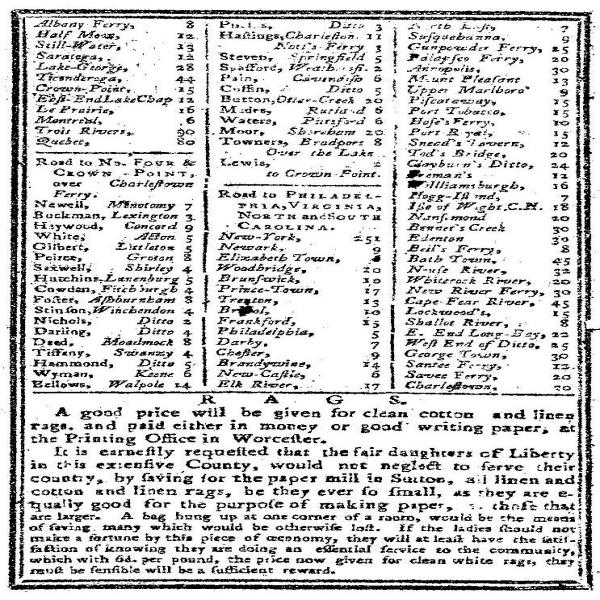Advertisement for rags
Original

Background Notes
The paper used in colonial times was generally made from the fibers of cotton or linen rags. It was printed while wet so that the fibers would be pliable. One of the jobs of an apprentice was to hang the wet paper to dry on racks suspended from the ceiling of the print shop.
Paper was always in short supply in colonial America. The scarcity of rags caused a great deal of problems for the manufacturing of paper during the Revolution. In fact, papermaking was regarded as such an essential occupation that skilled papermakers were able to secure exemption from military service during the war.1 Many newspapers, including Thomas’, frequently carried ads for rags that could be delivered to the printer’s office where they would be collected for shipment to the nearest paper mill.
This particular advertisement for rags was printed on the back of Isaiah Thomas’s Massachusetts, New Hampshire, and Connecticut almanack for the year of our Lord Christ 1779. Almanacs were little books published only once a year, and virtually every member of society consulted them daily. They were generally very inexpensive, only a few pennies each. Their most important function was to predict the weather, but they also contained medical remedies, anecdotes, recipes, public documents, poetry, passages from literature and history, and a wide range of other practical information.
Isaiah Thomas’ almanacs were extremely popular and lucrative publications. He began publishing a yearly almanac in 1771 and continued until 1801. Therefore, placing an ad for rags in one of his almanacs was an effective way of garnering a response. Furthermore, his plea that “the fair daughters of Liberty in this extensive County, would not neglect to serve their country, by saving for the paper mill in Sutton, all linen and cotton and linen rags,” made donating rags not only economical, but also patriotic. For it was through words, as well as battlefields, that the Revolutionary war was fought.
The paper mill in Sutton to which Thomas refers was established in Sutton, Massachusetts during the Revolution. There had been several paper mills in New England before the outbreak of war, but after 1775 mills increased rapidly all over the union. 2 Thomas himself, in order to secure a good steady supply of high quality paper to his own presses, established a mill at Quinsigamond (now a section of Worcester), Massachusetts, in 1793. This mill turned out approximately 1,400 pounds of paper per week. It employed eleven girls and ten men, one of whom was Zenas Crane, who would later found the famous Crane Paper Company in Dalton, Massachusetts.3 This company is still flourishing as one of the finest manufacturers of paper in the world.
Transcription of Primary Source
RAGS.
A good price will be given for clean cotton and linen rags, and paid either in money or good writing paper, at the Printing Office in Worcester.
It is earnestly requested that the fair daughters of Liberty in this extensive County, would not neglect to serve their country, by saving for the paper mill in Sutton, all linen and cotton and linen rags, be they ever so small, as they are equally good for the purpose of making paper, as those that are larger. A bag hung up at one corner of a room, would be the means of saving many which would otherwise be lost. If the ladies should not make a fortune by this piece of economy, they will at least have the satisfaction of knowing they are doing an essential service to the community, which with 6d. per pound, the price now given for clean white rags, they must be sensible will be sufficient reward.